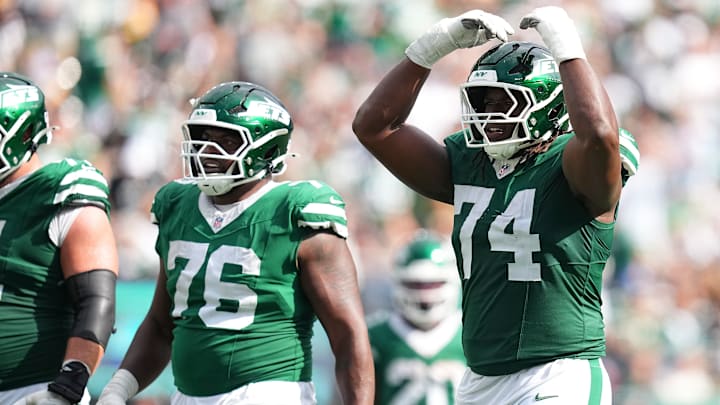The New York Jets have been on both ends of the offensive spectrum through their first two games of the 2025 NFL season. Week 1 featured a 32-point eruption, while Week 2 gave way to an anemic 10-point effort.
A lot changed from one week to the next. Justin Fields followed up the best performance of his career with the worst. Breece Hall went from dynamic with 107 rushing yards in Week 1, back to being a guy who is a likely trade candidate with just 29 yards on 10 carries as a complete non-factor against Buffalo.
With much of Week 1's success looking like a mirage, many are down (or back to where they started) on the Jets' offensive outlook for the rest of the season. But, with all clouds come a silver lining, and one stat points to a consistent standout performance that could change everything if the team can sustain it through the rest of the season.
Jets QBs lead the league in a surprising stat, thanks to the performance of the offensive line
There is no all-encompassing stat for evaluating offensive line performance, particularly in pass protection, but one stat is somewhat telling — average time to throw. After all, it stands to reason that if a quarterback has a high average time to throw, his line is keeping the pocket clean the majority of the time.
The two quarterbacks at the top of the list in this crucial stat are none other than Tyrod Taylor and Justin Fields. Taylor leads the way at 3.45 seconds on his drop-backs in relief of Fields following his exit with a concussion, but Fields isn't far behind at 3.37 seconds in a much larger sample.
Only six other quarterbacks with a minimum of 10 drop-backs average more than three seconds, with Caleb Williams coming in third behind the Jets' QB duo at 3.28 seconds, and C.J. Stroud rounding out the contingent with an even 3.00 seconds on average.
Out of the 35 QBs who meet this criteria, the average time to throw is 2.80 seconds, meaning that both Taylor and Fields have had over a half-second of additional time back there.
As stated earlier, this isn't the end-all, be-all. A QB can help himself by escaping pressure and buying more time, for example, but over a large enough sample, it's a pretty decent indicator as to whether or not an offensive line is giving its field general ample opportunity to work through his progressions.
Other metrics are less bullish. ESPN's pass blocking win-rate has the Jets ranked exactly middle of the pack, 16th, at 65%. PFF's pass block efficiency pegs the Jets at 25th with a mark of 81.2. The Denver Broncos reign supreme in this mark at 94.6, for reference.
None of these stats is entirely comprehensive, however. For example, a quarterback can scramble into a pressure, for instance, or the pressure can occur simply because he held onto the ball for too long. Wide receivers generating separation also play a role.
Football is truly a team game, which makes it hard to extricate these factors clearly once you get down to the nitty-gritty of it all.
For comparison's sake, the Jets only afforded Aaron Rodgers 2.65 seconds to throw last season. In 2023, Zach Wilson was provided with 2.92 seconds, while Tim Boyle and Trevor Siemien both managed just 2.48 seconds, and Brett Rypien came in at 2.74.
At the end of the day, it's clear that the Jets' offensive line is providing the quarterbacks with more time than ever before in recent memory to throw the ball. Now they just need receivers to consistently get open, the QBs to throw to them (accurately) once they do, and the running game as a complement.
It's a step in the direction of having a competent offense, no matter how small, and will be interesting to monitor as the season marches forward.
